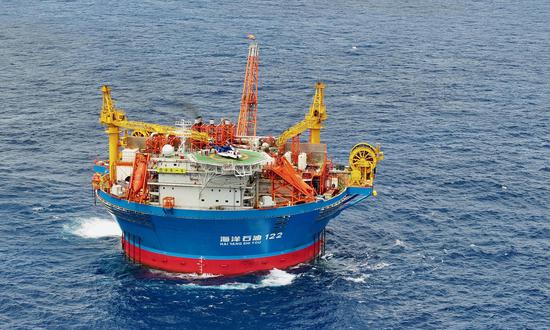China's first independently developed FPSO unit extends life of Liuhua oilfield in South China Sea by 30 years
"3, 2, 1, start the oil well!" With the command issued, the underwater robot slowly activated the subsea tree deep in the South China Sea. After preliminary processing by "Haiji No. 2," the crude oil was transported to "Haikui No. 1," located 2.5 kilometers away, where a high torch gradually ignited the natural gas.
On September 19, "Haikui No. 1," China's first independently developed floating production storage and offloading (FPSO) unit, began production. This also marks the first use of a cylindrical FPSO in Asia.
In just over a month, "Haikui No. 1" successfully completed its first crude oil export operation, signifying another major breakthrough for China in deep-water oil and gas development, according to a China News Service report.
"Haikui No. 1" is located 240 kilometers southeast of Shenzhen, South China's Guangdong Province, and serves as an offshore oil and gas processing facility that integrates crude oil production, storage, and export functions. It stands nearly as tall as a 30-story building, with a maximum oil storage capacity of 60,000 tons, read the report.
An FPSO is an offshore crude oil processing facility that combines production, storage, and export capabilities. "Haikui No. 1" can process approximately 5,600 tons of crude oil, enough to fuel 900,000 small cars simultaneously, according to Science and Technology Daily.
Construction of "Haikui No. 1" began in March 2022 in Qingdao, East China's Shandong Province. It consists of nearly 600,000 components and features an extremely compact structure. From a design perspective, it is already sophisticated, efficient, and intelligent. However, the design team had a strong commitment to develop a manufacturing solution suitable for Chinese waters and shipyards, addressing the challenge of long construction periods.
Among the six cylindrical FPSOs currently in operation worldwide, the longest construction period is 5.5 years. Previously, China built a cylindrical FPSO called "Penguin" under the commission of a foreign company, which took over four years. Through the efforts of the research team, the manufacturing of "Haikui No. 1" was completed in just 25 months, according to the Science and Technology Daily report.
"Haiji No. 2" was officially drilled on August 9, which was the first time that China exploited oil and gas through a fixed platform in waters more than 300 meters below. Haiji No. 2 is equipped with advanced automation systems, which include a robotic arm that enables "one-click operations" across various tasks, significantly enhancing the efficiency and stability of deep-water drilling.
"Haikui No. 1," in collaboration with the deep-water jacket platform "Haiji No. 2," has achieved China's first secondary development project for a deep-water oil field, extending the production life of the Liuhua oilfield by nearly 30 years. It also signifies that China has fully mastered integrated development technology for oil and gas engineering in waters deeper than 300 meters, creating a new model for the economical and efficient development of deep-water oil fields.
The Liuhua oilfield, where the two major national heavyweights are located, was put into production in March 1996. It is China's first deep-water oil field, with an average water depth of approximately 324 meters and proven geological reserves exceeding 160 million tons. After 28 years of extraction, the oil field has contributed over 23 million tons of deep-water oil and gas. To improve the overall recovery rate of the oil field and carry out secondary development, there are plans to build 32 new wells, with the peak daily oil production expected to reach 2,700 tons, as reported by CCTV.

